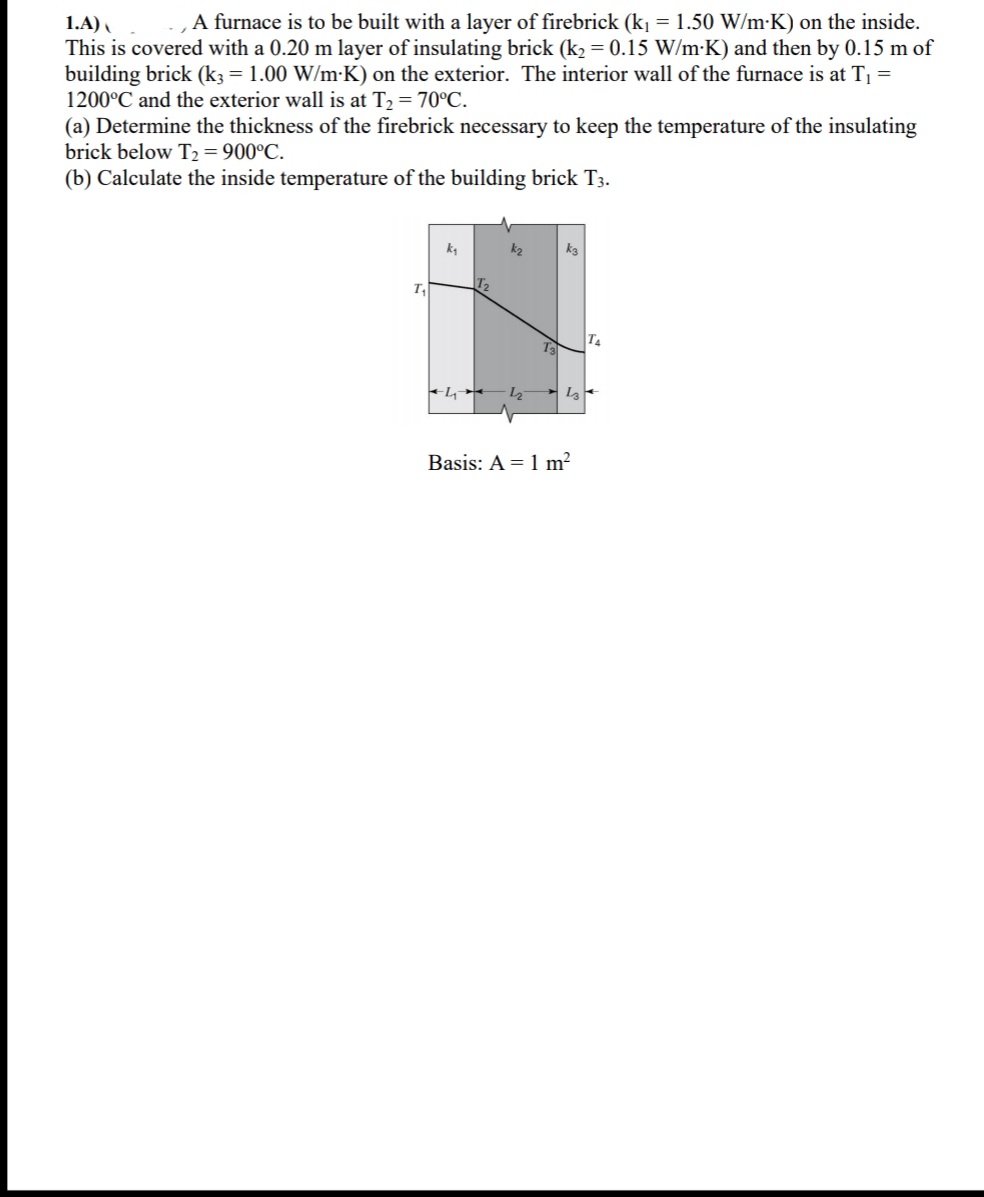%3D A furnace is to be built with a layer of firebrick (k = 1.50 W/m-K) on the inside. This is covered with a 0.20 m layer of insulating brick (k2 = 0.15 W/m-K) and then by 0.15 m of building brick (k3 = 1.00 W/m•K) on the exterior. The interior wall of the furnace is at T1 = 1200°C and the exterior wall is at T2 = 70°C. (a) Determine the thickness of the firebrick necessary to keep the temperature of the insulating brick below T2 = 900°C. (b) Calculate the inside temperature of the building brick T3. 1.A) %3D k2 T2 TA Basis: A = 1 m?
%3D A furnace is to be built with a layer of firebrick (k = 1.50 W/m-K) on the inside. This is covered with a 0.20 m layer of insulating brick (k2 = 0.15 W/m-K) and then by 0.15 m of building brick (k3 = 1.00 W/m•K) on the exterior. The interior wall of the furnace is at T1 = 1200°C and the exterior wall is at T2 = 70°C. (a) Determine the thickness of the firebrick necessary to keep the temperature of the insulating brick below T2 = 900°C. (b) Calculate the inside temperature of the building brick T3. 1.A) %3D k2 T2 TA Basis: A = 1 m?
Introduction to Chemical Engineering Thermodynamics
8th Edition
ISBN:9781259696527
Author:J.M. Smith Termodinamica en ingenieria quimica, Hendrick C Van Ness, Michael Abbott, Mark Swihart
Publisher:J.M. Smith Termodinamica en ingenieria quimica, Hendrick C Van Ness, Michael Abbott, Mark Swihart
Chapter1: Introduction
Section: Chapter Questions
Problem 1.1P
Related questions
Question

Transcribed Image Text:1.A)
A furnace is to be built with a layer of firebrick (k1 = 1.50 W/m-K) on the inside.
This is covered with a 0.20 m layer of insulating brick (k2 = 0.15 W/m-K) and then by 0.15 m of
building brick (k3= 1.00 W/m-K) on the exterior. The interior wall of the furnace is at T1 =
1200°C and the exterior wall is at T2 = 70°C.
(a) Determine the thickness of the firebrick necessary to keep the temperature of the insulating
brick below T2 = 900°C.
(b) Calculate the inside temperature of the building brick T3.
k2
T2
T
T4
L2
Basis: A = 1 m²
Expert Solution
This question has been solved!
Explore an expertly crafted, step-by-step solution for a thorough understanding of key concepts.
This is a popular solution!
Trending now
This is a popular solution!
Step by step
Solved in 3 steps with 1 images

Knowledge Booster
Learn more about
Need a deep-dive on the concept behind this application? Look no further. Learn more about this topic, chemical-engineering and related others by exploring similar questions and additional content below.Recommended textbooks for you

Introduction to Chemical Engineering Thermodynami…
Chemical Engineering
ISBN:
9781259696527
Author:
J.M. Smith Termodinamica en ingenieria quimica, Hendrick C Van Ness, Michael Abbott, Mark Swihart
Publisher:
McGraw-Hill Education

Elementary Principles of Chemical Processes, Bind…
Chemical Engineering
ISBN:
9781118431221
Author:
Richard M. Felder, Ronald W. Rousseau, Lisa G. Bullard
Publisher:
WILEY

Elements of Chemical Reaction Engineering (5th Ed…
Chemical Engineering
ISBN:
9780133887518
Author:
H. Scott Fogler
Publisher:
Prentice Hall

Introduction to Chemical Engineering Thermodynami…
Chemical Engineering
ISBN:
9781259696527
Author:
J.M. Smith Termodinamica en ingenieria quimica, Hendrick C Van Ness, Michael Abbott, Mark Swihart
Publisher:
McGraw-Hill Education

Elementary Principles of Chemical Processes, Bind…
Chemical Engineering
ISBN:
9781118431221
Author:
Richard M. Felder, Ronald W. Rousseau, Lisa G. Bullard
Publisher:
WILEY

Elements of Chemical Reaction Engineering (5th Ed…
Chemical Engineering
ISBN:
9780133887518
Author:
H. Scott Fogler
Publisher:
Prentice Hall


Industrial Plastics: Theory and Applications
Chemical Engineering
ISBN:
9781285061238
Author:
Lokensgard, Erik
Publisher:
Delmar Cengage Learning

Unit Operations of Chemical Engineering
Chemical Engineering
ISBN:
9780072848236
Author:
Warren McCabe, Julian C. Smith, Peter Harriott
Publisher:
McGraw-Hill Companies, The